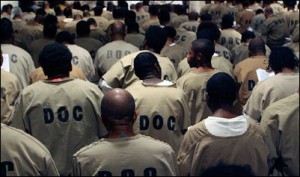Are we using prison and jail too much? Do we put people behind bars with long sentences as a means to attempt to curb the crime rate? Many refer to this as mass incarceration.
First, though, let me first start by framing this and giving you a bit of context and background…
The United States has the highest incarceration rate in the world – with over 2.2 million individuals behind bars today. This is about a 500 percent increase in the past 40 years. Further, even though the U.S. has only five percent of the world’s population, it houses 25 percent of the world’s prison population. If those numbers were not alarming enough, there are another 4.75 million on some type of state supervision, such as probation or parole.
A disproportionate number of of people incarcerated are African-American males. Of the over two million incarcerated today, almost 40% are black men; one in nine black men between the ages of 20 and 34 are behind bars today. And, one-third of all black men will be incarcerated at some point of their life. Twenty percent of those incarcerated are Hispanic males.
While crime rates in the U.S. have consistently decreased for 24 years, the number of incarcerated people has continued to rise over the majority of that period. This is attributed to both more people being sent to prison for offenses that once were punished with other measures and longer sentences. For example, even though the number of violent crimes has gradually decreased over the past two decades, the number of offenders serving life sentences has progressively risen. Today, one in nine prisoners are serving a life sentence.
So, the question is, why the unprecedented rise over the decades? The situation: mass incarceration. There are a few different factors associated with this – and it is not just non-violent drug offenders who are associated with mass incarceration, as many often say. There is much more to it.
Starting in the 1970’s, we began sending people convicted of rather minor crimes to prison for longer periods of time – this is where it all started.
Next, the war on drugs began, sending more and more to prison for longer periods of time.
Then, in the early to mid-90’s, we saw sentence increases for a wide variety of crimes, including life sentences and life without parole.
Establishing these efforts was packaged and sold as “getting tough on crime.” The fact that mass incarceration contributed to a social restructuring was not discussed at the time. Folks who suffered from mental health issues and survivors of trauma and abuse were just rounded up and sent into the system where they now eat up a tremendous amount of taxpayer dollars.
Much of the recent debate on mass incarceration has focused on federal sentencing laws and reform of drug policies. However, the real problem with mass incarceration has taken place on the state level. Fifty-seven percent of America’s inmates are in state prison. And, 30 percent are in local jails, usually for violating state laws. Of course, jail and prison rates vary from state to state, but almost all states have enacted some sort of policy that led to mass incarceration. This includes efforts such as mandatory minimum sentences, truth in sentencing laws, three strikes you’re out, and/or abolition of parole. All of these policies are directed toward incarcerating people for much longer lengths of time.
Digging deeper, state spending on corrections increased 400 percent between 1980 and 2009. This now equates to jails and prisons being primary providers for health care, mental health, counseling, job training, and education to our nation’s poorest population.
The question is: Has crime gone down since these measures for mass incarceration began? YES! Does this mean mass incarceration has worked? NO!
Why you may ask? Stay tuned for next week’s blog for my thoughts on this.
Sarah Scarbrough is internal program director for the Richmond City Justice Center. This essay was originally published on her blog.



